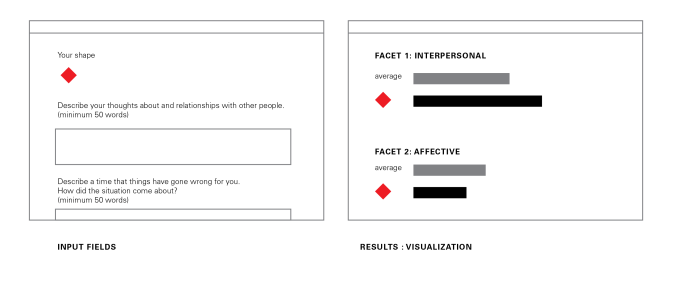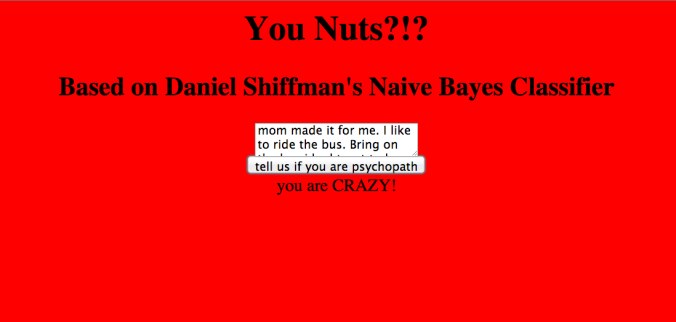Crowd Ranked Psychopathy Test
by Woonyung and Claire
site: http://104.131.191.77:8080/

Splash page with instructions for use and questions that address the same four facets evaluated in the PCL-R
Final Project Proposal
Crowd Ranked Psychopathy Test
by Woonyung and Claire
Woonyung and I are interested in continuing our work to recreate a programmatic version of the PCL-R (see Assignment 3). We failed to get transcripts from the creator of the PCL-R, but are continuing ahead by training the Bayesian algorithm with more interview transcripts and have created our own dictionaries of highly salient phrases and words based on the literature behind the PCL-R’s four facets (interpersonal, affective, lifestyle, and antisocial indicators).
We would like to add a dimension of anonymity and group participation, as well. In its final iteration, we will involve our whole class by asking them to answer questions based on the PCL-R’s facets and visualize the results together. We will assign users a shape of distinct size and color before filling out the form, so they may identify their ‘ranking’ or positioning amongst their peers. We feel this approach adds a dimension of crowd ranking, or peer to peer comparisons and is a gentler way of communicating results (avoiding stigma and acknowledging that this is not a diagnostic tool).
Here is a diagram of what we hope to create:
Assignment 4
This week’s Assignment was to generate text using code. My Javascript uses a Markov Chain algorithm to generate a jumbled denomination from a list of 376 real Christian denominations.
http://cleezyitp.github.io/DenominationSelector/#
Assignment 3
R U NUTS?!
Assignment 1
A) Simple text manipulation in Javascript:
I wrote a code that translates user input into Canadian.
Code found here
B)Bottle exercise
Actual exercise found here
Description: In this exercise, users are prompted to type a description of a picture for 5 minutes. After doing this, a program analyzes the text and rates how users view the picture compared to others.
In my case, not very well. Below is a screenshot of how I performed:
I was surprised to learn that I scored far below average on most dimensions and high above the average for contextual thinking. I would have assumed my perceptual style leaned towards visual because of my training in art therapy and the visual arts, but for whatever reason I was hell bent on describing the lighting and negative space in this photo (not visual???). It interests me to think of speech analysis as a way to illuminate the subtle nuances of how we relate to ourselves, others and the world around us. In my own research, I have used grounded theory to extract themes / qualitative data from long transcripts of participant interviews. However, (and this may be true to my contextual thinking score!!!) I think it would be a stretch to say that the interpretation of my outcome from this particular example would be replicated in different scenarios. For example, I think if the label of the bottle was more legible, I may have described the logo and text more and focused less on contextual elements. I have read through some of Pennebaker’s work, and think it is very interesting. I am a bit skeptical about the reliability and accuracy of the interpretations from this particular exercise and would like to know more about the decisions that were made to when developing the rating/classification system.



